Check out my custom vibration dampener
15 Best Tennis Racquets for Beginners 2024
Discover a Frame You’ll Love
We hope you love this article. Just so you know, TennisCompanion may collect a small share of sales from the links on this page to help keep this site running. Learn more.
If there’s one thing that can make getting started with tennis tricky, it’s the dizzying selection of tennis racquets coupled with marketing jargon that suggests every tennis racquet is the best.
Today, I’ll walk you through a step-by-step approach for selecting a racquet if you’re new to the game and share my recommendations and reviews of the best tennis racquets for beginners in 2024.
If you’re looking for a sneak peek at what’s to come, you can check out my top picks for beginner racquets below.
Keep scrolling to check out all 15 of my favorites and learn which racquet is best for you.
Article Contents
Click below to jump to a section
Tap below to jump to a section
Does My Racquet Matter?
Questions to Ask Yourself
Types of Tennis Racquets
Key Racquet Attributes
Popular Racquet Brands
Men’s vs. Women’s Racquets
Beginner vs. Intermediate
Tennis String Basics
Racquet Guide for Beginners
Best Beginners Racquet
How to Choose a Racquet
Common Questions
Racquet Index
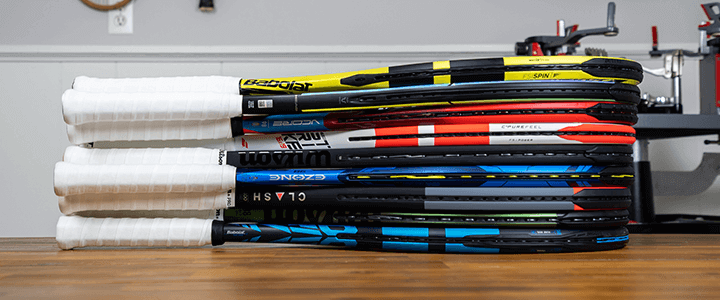
I’ve dedicated the first portion of this guide to helping players learn more about racquets, including questions to ask yourself and what to look out for when buying a new tennis racquet.
If you’d like to skip this information, click any of the following links to read up on each racquet I’ve selected and why it made my list.
- Babolat Boost Drive
- Babolat Boost Aero
- Babolat Boost Strike
- Babolat Pure Strike EVO
- Wilson Clash 108
- Wilson Hyper Hammer 5.3
- Wilson Ultra 108 v4
- Wilson Burn 100LS v5
- Head Titanium Ti.S6
- Head Speed PWR
- Head Instinct PWR
- Head Extreme PWR
- Yonex EZONE Ace
- Prince Textreme Warrior 100L
- Tecnifibre TF-X1 275
Ready to get started? Let’s dive in!
Does it Matter Which Racquet I Choose?
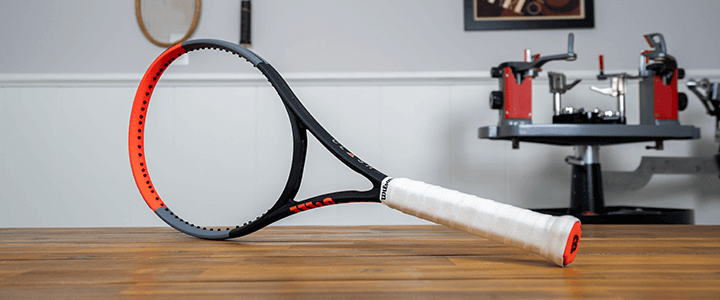
I’m going to level with you. As a beginner, your tennis racquet won’t make a significant difference on day one or early on as you learn. Don’t get me wrong; there are good and bad tennis racquets for beginners and key attributes I’ll share that you should consider.
However, many players new to the game overemphasize the importance of their tennis racquets when first getting started.
The hard truth is that buying Roger Federer’s tennis racquet will not help you play better. In fact, for most beginners, it would be a poor choice (more on that to follow).
At the same time, zero consideration for your racquet won’t set you up for success either. As I’ll cover, a few key racquet attributes can help make learning how to play tennis as a beginner easier and more fun.
Questions to Ask Yourself
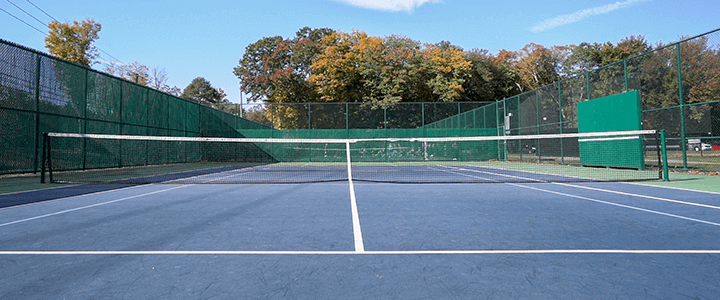
As a beginner the following two questions are helpful to consider before choosing a new tennis racquet as a beginner. If you can answer “yes” to either of the following questions, then the racquets I cover in this article will be terrific options.
On the other hand, if you answer “no” to either of them, you may want to consider something less expensive.
Is your budget more than $50 for your racquet?
If you don’t have much to spend and are just getting started, that’s perfectly fine. You don’t have to overspend to get started playing tennis. My list of affordable tennis racquets offers an excellent selection to choose from to get a feel for the game, and you can always upgrade later.
On the other hand, if you have a little extra to spend, you’ll likely come to appreciate the nuanced differences in my selection of performance racquets for beginners as your skills improve. Of course, that brings us to my next question.
Are you committed to improving your game?
If you want to get out on the court with friends a few times a year and don’t intend to play tennis frequently, then there isn’t much reason to spend a bunch of extra money on a tennis racquet. You’ll have plenty of fun with an inexpensive racquet.
However, if you plan on taking lessons or committing yourself to play for the long haul, you’ll likely appreciate what a mid-range model offers as your skills develop.
The most important takeaway is that your tennis racquet won’t make you a better player. Give Rafael Nadal a $20 kids tennis racquet, and you know he’ll still dominate 98% of tennis players.
Instead, a quality tennis racquet can complement a player’s style of play and enhance their skills, but it all starts with building the fundamentals, which takes time.
Types of Tennis Racquets
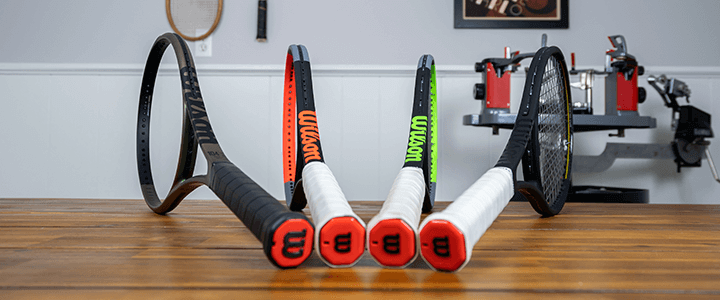
To better understand why I’ve selected and recommended the tennis racquets in this article, it’s helpful to understand the different types of tennis racquets. They are as follows:
- Power
- Control (players)
- Tweener
- Modern players
Let’s quickly review each racquet below to highlight the differences and the type of player that will benefit from each.
Power Racquets
As the name suggests, manufacturers have designed this category of tennis racquets to provide players with easy access to power. To accomplish this, you’ll typically find these racquets have the following attributes:
- Large head size
- Stiff frame
- Open string pattern
- Lighter weight
The larger head sizes increase a player’s margin for error when swinging, which, combined with the stiff frame and open string pattern, return more energy to the ball and provide easier access to power. At the same time, the lightweight frames make them easier to swing and handle.
This combination of attributes ensures they’re a popular option for beginners and an older generation of tennis players who still enjoy the game late into their lives but need something lighter and easier to handle.
You may also hear these called game improvement racquets, referring to how this type of racquet can help take a player’s skills from beginner to intermediate.
Control (Players) Racquets
On the opposite end of the spectrum, you have a selection of tennis racquets that emphasize control and are often called players’ racquets.
The following attributes are frequently shared as part of this category of racquets to help provide players with more precision:
- Smaller head size
- Flexible frame
- Closed string pattern
- Heavier weight
The above features combine to produce a frame that delivers more control to players while requiring a finely tuned technique to generate power, aided by the frame’s weight.
Of course, the smaller head size reduces a player’s margin for error, and heavier racquets are more demanding for an inexperienced player to maneuver. As a result, I don’t recommend control racquets for beginners.
Earlier, I mentioned that Roger Federer’s racquet typically isn’t an ideal choice for beginners. That’s because it’s one of the heaviest control racquets on the market that will tend to frustrate a new player and generally is a better option for players to consider once their skills develop.
Helpful Tip
Many new players read the description for control racquets and quickly conclude that buying a control racquet will solve all their problems and keep the ball in the court.
It’s important to note that while the design of a control racquet will enhance a player’s ability to control and direct the ball, it’s typically not a difference that a beginner will detect as it’s nuanced.
Tweener Racquets
At first glance, the name of this racquet might throw you off, but this is a common category of tennis racquets that strive to balance power and control racquets, i.e., somewhere in between, which is how they get their name.
As you’d expect, their attributes tend to fall somewhere in the middle:
- Mid-sized head
- Balanced flex, frequently with a lean toward a higher stiffness rating
- Open string pattern
- Mid-range weight
All in all, you’ll see a broader mix of attributes associated with tweener racquets as manufacturers tweak them to appeal to various styles of play.
With that said, adults often consider power racquets as an option, while younger players who are just starting tend to gravitate toward tweener racquets.
Each can be a fantastic option for both groups of players and provide a terrific starting point while allowing players to grow into them.
Modern Players Racquets
For years, the control or players racquet was the go-to choice for many advanced and professional tennis players.
However, with the rise of polyester tennis strings in the 90s and early 2000s, a new kind of tennis racquet emerged, often referred to as a modern player’s racquet.
Here are the attributes that you can expect from this style frame:
- Mid-sized head, although often slightly on the smaller side
- Balanced flex, frequently with a lean toward a higher stiffness rating
- Open string pattern
- Heavier weight
In many ways, the modern player’s racquet is a slightly heavier version of the tweener tennis racquet, usually with a 98 or 100 sq in head size.
These frames deliver excellent spin while having plenty of mass for the stability to hang with heavy-hitting players.
Key Racquet Attributes for Beginners
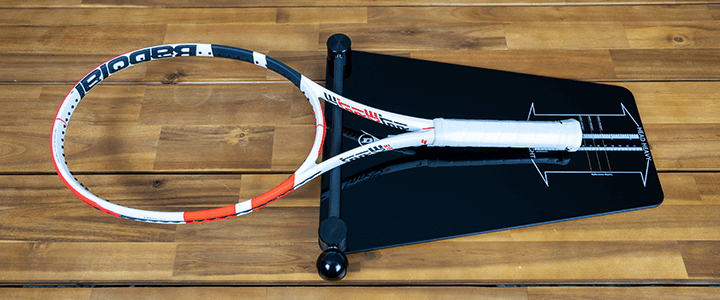
When purchasing a tennis racquet, there are a variety of attributes to be aware of and a few key characteristics to consider. Below, I’ll share the three most important for beginners and cover a few others for reference.
Grip Size
When you buy an adult-size tennis racquet, you’ll select a grip size that refers to the measure of the handle’s circumference.
Finding the right grip size can help prevent injury by avoiding a grip that’s too small or too large, but it’s mostly a preference, i.e., you want to find something comfortable.
Here’s a table that shows you the different size grips.
| US Sizes | European Sizes | Sizes in mm |
| 4 inches | 0 | 100-103 mm |
| 4 1/8 inches | 1 | 103-106 mm |
| 4 1/4 inches | 2 | 106-110 mm |
| 4 3/8 inches | 3 | 110-113 mm |
| 4 1/2 inches | 4 | 113-118 mm |
| 4 5/8 inches | 5 | 118-120 mm |
| 4 3/4 inches | 6 | 120-123 mm |
While selecting the right grip size isn’t an exact science, there is a simple measurement of your hand that you can take to get in the right ballpark – all you need is a ruler.
With your ruler, measure from the tip of your hand’s ring finger down to the bottom crease on your hand that starts between your pointer finger and thumb and runs sideways. Here’s a photo for reference.
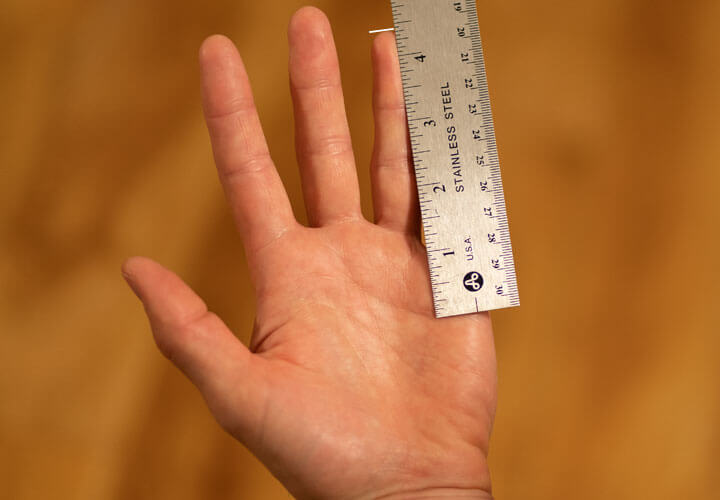
In the photo, you can see my hand measures just above 4 3/8 or 109 mm. Most players don’t find their measurements aligning precisely with the chart like mine. If you’re buying online, I’d recommend you purchase a grip size smaller than your measurement because while you can increase the grip size, it’s much more challenging to make it smaller.
However, I recommend you head out to any store that sells adult tennis racquets and hold the two grip sizes closest to your measurement to get a feel for things. Whichever is more comfortable is the grip I’d recommend.
Head Size
The head size of a tennis racquet is a square inch or centimeter measurement of a racquet’s head where you’ll find the strings. For beginners, head size is important for two key reasons.
First, a larger head size will make it easier to hit the ball or increase your margin for error when swinging because the stringbed is larger. Select a racquet head that’s too small, and you may find the ball hitting the frame often, which is a quick recipe for frustration.
Second, a larger head size will generally provide easier access to power, which is a welcome feature as you develop proper technique, build muscle memory, and learn to generate power independently.
For context, head sizes typically range from 93-107 square inches. As a beginner, I highly recommend you consider racquets with a 100-square-inch head size or higher.
Weight
Next up, another essential characteristic to consider as a beginner is the weight of the tennis racquet. Generally, retailers and manufacturers express the weight of a racquet as the strung weight, which, as you probably guessed, is the racquet’s weight with strings installed.
Weight plays a significant role in the performance of a tennis racquet. However, when starting, you should avoid buying a racquet that’s too heavy. You want it to be easy to maneuver and comfortable to hold for an extended period.
Most racquets will fall between 10.5 and 12.6 ounces strung, but I recommend staying at or below roughly 11.6 ounces for beginners.
Keep in mind that strings will add about 18 grams or 0.6 ounces to the racquet’s weight, so if you’re evaluating a racquet that displays its unstrung weight, you won’t want to exceed 11 oz.
Other Attributes
When you’re just starting, I encourage you to avoid getting wrapped up in the following attributes, but I always encourage players to become familiar with them.
Below, I’ll walk through exactly what each attribute represents, how they’re measured, and how they impact racquet performance.
- Balance: Racquets will either be head light (HL), head heavy (HH), or equal balance (EB), which represents the distribution of weight for the racquet and is measured in points, i.e., 4pts HL. Many beginners appreciate HL tennis racquets because having more weight toward the handle makes it easier to swing and maneuver them.
- Swingweight: Not to be confused with strung weight, this measures how heavy a tennis racquet feels when swinging and can help compare one racquet to another. The balance of a tennis racquet substantially impacts the swingweight and is expressed as a numeric value, i.e., 324.
- Stiffness: A stiffness or RA rating represents the flex a tennis racquet exhibits and is a numeric value, i.e., 67. Generally speaking, the stiffer a racquet, the more power or energy will be returned to the ball, while a frame with more flex will result in less power and, subsequently, more control for a player. It’s also worth noting that stiffer racquets offer less comfort, with more feedback, i.e., shock and vibration, traveling to a player’s hand and arm.
- Beam Width: The beam of a tennis racquet measures the frame’s width in millimeters. Some racquets will have a consistent beam width all the way around, while others will vary at different points around the edge. Typically, a thicker beam produces more power, while a thinner beam has less power.
- String Pattern: The string pattern of a tennis racquet refers to the number of main or vertical and cross strings. An open string pattern increases power and spin, while a closed pattern typically provides more control. A tennis racquet with fewer mains and crosses has an open string pattern, i.e., 16×19, while on the other end of the spectrum, you’d end up with a closed string pattern, i.e., 18×20.
Popular Racquet Brands
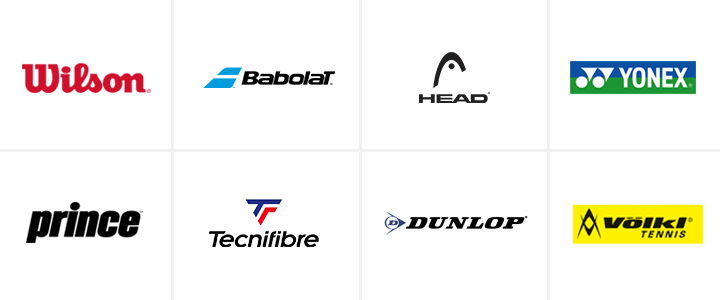
Now that you’re familiar with the essential racquet attributes to be aware of, let’s quickly touch on a few popular tennis brands you’ll come across.
By far, the most popular racquets these days come from four major brands that include:
- Wilson
- Babolat
- HEAD
- Yonex
A few others to be aware of include:
- Prince
- Tecnifibre
- Dunlop
- Volkl
The truth is each of these manufacturers produces excellent frames that cater to a wide range of players, and much of the decision for which brand to go with comes down to personal preference.
Men’s vs. Women’s Tennis Racquets
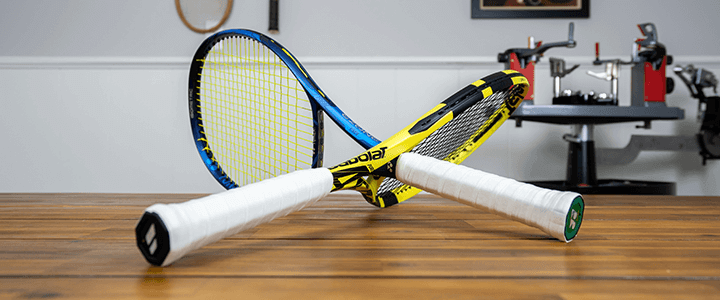
A common question for players new to the game is whether there is a difference between men’s and women’s racquets. Today, virtually all tennis racquets are unisex, and you’ll find top men and women using the same models.
One exception is the Technifibre Tempo, which is marketed specifically for women and, per Technifibre, seeks to account for women’s common physiological traits. However, plenty of tennis racquets accomplish the same goal without being explicitly marketed toward women.
With that said, some tennis racquets are more popular with women or men because of their attributes, and manufacturers often market their racquets accordingly. The most significant characteristic that I advise female players around is racquet weight.
In recent years, racquet manufacturers have recognized the demand for lighter versions of their popular models, so it’s more common than ever to find these available. However, men and women use light versions of their frames, so they are not explicitly female racquets.
Beginner vs. Intermediate Tennis Racquets
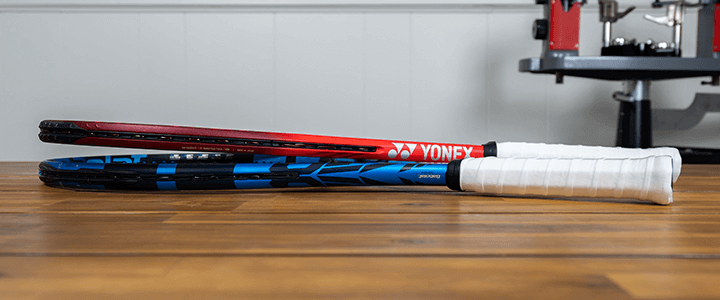
Another common question I get from students is the difference between beginner and intermediate tennis racquets. The truth is, it can get a bit fuzzy, but let’s break it down.
There are three factors that we can use to distinguish between beginner and intermediate racquets:
- Cost
- Construction
- Materials
Cost
Beginner tennis racquets will often sell for less than $150. However, this does not mean that more expensive racquets cannot be a great fit for beginners.
Construction
Beginner tennis racquets will usually feature more straightforward construction than intermediate tennis racquets. Again, this isn’t a hard rule, but it tends to be true.
Materials
Most beginner tennis racquets won’t use advanced materials because they’re more expensive, and new players won’t benefit dramatically from them when starting.
On the other hand, intermediate tennis racquets often feature the latest and greatest racquet technology.
Where it gets muddy is racquets that are the exception to the above rules, i.e., cost more than $150 and feature advanced construction and materials, and there are plenty on the market, including a few on this list.
These pricier tennis racquets that work for beginners are often lightweight with oversized heads (above 100 square inches). However, these racquets are also suitable for some intermediate tennis players.
Here’s a table to help paint a picture:
| Attribute | Beginner | Intermediate |
| Price | Under $150 | $100+ |
| Head Size | 100 sq. in. and up | 100 – 105 sq. in. |
| Weight | 10.5 ounces or less | 9.5 – 11 ounces |
Although beginner tennis racquets tend to have a specific set of defining features, there is some crossover between intermediate and a selection of racquets that work well for both groups.
Next up, let’s look at tennis strings and what to expect when getting started.
Tennis String Basics
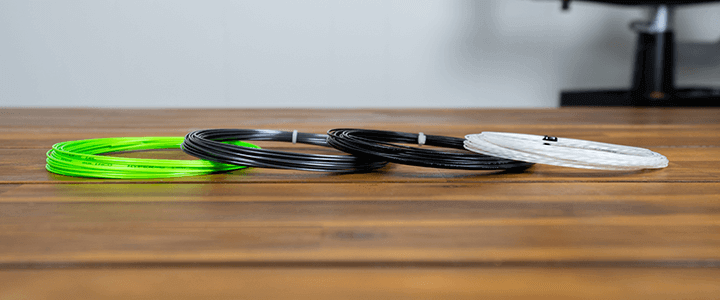
I’d be remiss in covering the best tennis racquets for beginners without mentioning tennis strings, so let’s dive in for a quick review.
Luckily, you won’t need to worry too much about your tennis strings when just starting with tennis. The differences that various strings offer are relatively nuanced and will be hard to detect for new players.
However, as your technique and skills develop, you’ll find the strings you use and
the tension you string your racquet can dramatically impact your racquet’s performance.
For that reason, I want to provide some helpful information regarding the different types of tennis strings you’ll encounter and the key factors to consider when selecting a set of strings as a beginner.
Types of String
The following are the two main broad categories of tennis strings:
- Natural Gut: Made from cow gut or intestine, these are some of the highest quality strings money can buy. However, due to their susceptibility to moisture, somewhat lower durability, and high cost, they aren’t the most popular, and I don’t recommend them for beginners.
- Synthetic: Most strings are synthetic, providing players of all levels with numerous options and price points. This type of string has come a long way, and they’re now the preferred string for most tour-level and amateur players who prefer the performance characteristics and cost of a synthetic over natural gut.
You’ll find a few different materials within the synthetic bucket of tennis strings. The two most popular are nylon and polyester strings, which provide players with contrasting playing characteristics.
Here’s a high-level overview of what you can generally expect from each:
Nylon
- A softer material
- Power
- Arm friendly
- Low durability
- Good tension maintenance
Polyester
- A stiffer material
- Control
- Topspin
- High durability
- Lower tension maintenance
It’s worth reiterating that the above characteristics aren’t hard and fast rules. Instead, they’re rough guidelines for what to expect with each material. Another element that comes into play is the nylon or polyester quality, which the price of a string typically reflects.
Construction
Beyond the material used, it’s worth noting that strings are also frequently constructed in different ways. I won’t dive too deep here, but two popular string constructions are multifilament and monofilament.
Multifilament tennis strings consist of hundreds or thousands of nylon microfibers woven together. On the other hand, monofilament strings are made of a single solid filament and are how you’ll frequently find polyester strings made.
Gauge
Finally, it’s good to know that strings come in different thicknesses or gauges. As you may have guessed, durability is a factor in that thicker strings are harder to break.
However, the thickness of a string also impacts the spin potential and feel of a set of tennis strings – thinner strings typically provide more spin and feel while being susceptible to breakage.
Here’s a quick table of the various gauges available for reference:
| Gauge | Min (mm) | Max (mm) |
| 19 | 1.00 | 1.10 |
| 18 | 1.10 | 1.16 |
| 17L | 1.16 | 1.20 |
| 17 | 1.20 | 1.24 |
| 16L | 1.22 | 1.26 |
| 16 | 1.26 | 1.33 |
| 15L | 1.34 | 1.40 |
| 15 | 1.41 | 1.49 |
Helpful tip
Notice that the higher the gauge, the thinner the string. New players often assume the opposite, so it’s worth noting.
Recommended Strings for Beginners
As a beginner, I’d recommend focusing your string selection on two key factors: price and durability.
Regarding price, you don’t need to overspend on tennis strings when getting started because it will be hard to detect the difference between one set and another. From a durability standpoint, you also want to avoid being forced to replace your strings frequently, so getting something durable and lasting is a great option and will save you some extra cash.
Here are some guidelines I’d recommend for your first set of strings:
- Price: $10 or less
- Material: Synthetic/nylon
- Gauge: 16
For reference, a few popular options include:
As you’ll see in the guide below, many beginner tennis racquets come pre-strung. Of course, you won’t have to worry about choosing tennis strings if you select one of those racquets.
Restringing Your Racquet
It’s worth noting that you’ll need to restring your racquet periodically. As a beginner, the main factor to consider is your frequency of play.
As a general rule of thumb, I encourage players to think about how many times they play per week on average and then double that number for the number of times they should restring per year. For example, if you play twice a week, you should restring four times a year or every three months.
Check out my article on how frequently to restring for an in-depth review of factors to consider, including how to know when it’s time.
Racquet Guide for Beginners
Hopefully, you’re feeling equipped with the essential pieces of information that will help you select the best tennis racquet for your needs.
Of course, I want to help narrow things down for you, so I’ve compiled a list of my 15 favorite racquet picks for you to consider.
The Best Tennis Racquet for Beginners
With a wide range of tennis racquets for beginners, my top pick for 2024 goes to the Babolat Boost Drive.
Babolat Boost Drive

The Babolat Boost Drive delivers on all fronts for a beginner tennis racquet. First, its 105 square inch head is a great size when a player is getting started – not too big or too small, and it’s the most forgiving head size in the Boost lineup.
Next, it features an open 16×19 string pattern (16 main and 19 cross strings), which helps it pack some extra punch and plenty of topspin.
At 9.2 ounces, it’s also light and easy to maneuver, which is ideal for beginners looking to develop their strokes. Add a very reasonable price point to that, and it comes in as my pick for the best tennis racquet for beginners in 2024.
Key Specs
| Head size | 105 in² / 677 cm² |
| Strung weight | 9.2oz / 260g |
| Power | Medium |
| String Pattern | 16 Mains / 19 Crosses |
| Pre-strung | Yes |
Babolat Tennis Racquets
Babolat offers up an outstanding category of tennis racquets for new players that come with the Boost name at terrific price points. While the Babolat Boost Drive is my favorite pick, the Aero and Strike models I discuss below are also excellent for beginners.
Babolat Boost Aero
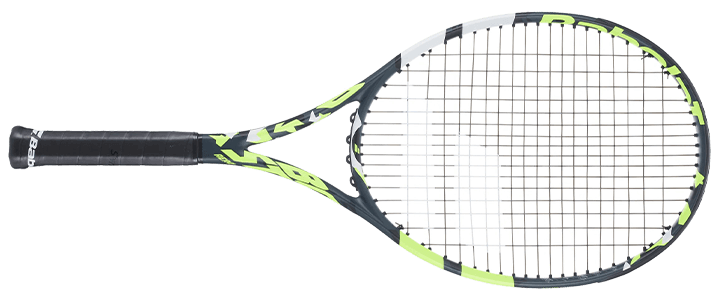
If you’re a Nadal fan, you’ll likely recognize the paint job of this tennis racquet. The Boost Aero is the younger sibling to Nadal’s stick of choice, the Babolat Pure Aero, but it’s priced at a fraction of the cost, making it a great starter frame for any beginner.
The racquet is the same 9.7-ounce weight as the Boost Drive for easy maneuverability, but its smaller head size results in less power. At the same time, its 16×19 string pattern provides plenty of access to spin.
This racquet sits comfortably between the Boost Drive and the next racquet, the Boost Strike, regarding power and control.
Key Specs
| Head size | 102 in² / 658 cm² |
| Strung weight | 9.7oz / 275g |
| Power | Medium |
| String Pattern | 16 Mains / 19 Crosses |
| Pre-strung | Yes |
Babolat Boost Strike

Key Specs
| Head size | 102 in² / 658 cm² |
| Strung weight | 10.4oz / 295g |
| Power | Medium |
| String Pattern | 16 Mains / 19 Crosses |
| Pre-strung | Yes |
Babolat Pure Strike EVO

Finally, the Babolat Boost Strike EVO is an excellent alternative to the Babolat Boost Strike. They feature identical head sizes, but the Pure Strike EVO is almost a half-ounce lighter at 10 ounces.
This model falls between the Boost Strike and the higher-end performance Pure Strike in materials, construction, and tech.
However, as the Pure Strike family’s lightest option, it swings easier while maintaining a mid-range RA rating of 65, which will help players maintain comfort when striking the ball.
Key Specs
| Head size | 102 in² / 658 cm² |
| Strung weight | 10oz / 283g |
| Power | Low |
| String Pattern | 16 Mains / 19 Crosses |
| Pre-strung | Yes |
Wilson Tennis Racquets
With an extensive lineup of tennis racquets used by legends like Roger Federer and Serena Williams, Wilson is well-known for building tennis racquets that deliver performance. The following are my favorite picks for beginners.
Wilson Clash 108
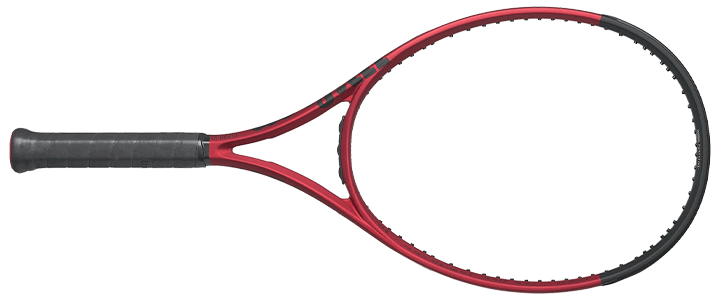
The Wilson Clash 108 is a unique racquet on this list for beginners and delivers maximum comfort. Many racquets skew heavily toward power or control, but the Clash seeks to balance an arm-friendly tennis racquet with an exceptional response.
With a 10.4-ounce weight, extended 27.25-inch length, and large 108 square-inch head, the Wilson Clash 108 is a delightfully easy-to-use racquet. This racquet is excellent if comfort without sacrificing performance is a priority.
Key Specs
| Head size | 108 in² / 697 cm² |
| Strung weight | 10.4oz / 295g |
| Power | Medium |
| String Pattern | 16 Mains / 19 Crosses |
| Pre-strung | No |
Wilson Hyper Hammer 5.3

At 9 ounces, the Hyper Hammer 5.3 is an ultra-lightweight tennis racquet with an oversized head of 110 square inches. With a half-inch extended length of 27.5 inches, beginners will find it has more than enough power and a forgiving response.
This racquet differs from others on my list because it still has a good weight when swinging, known as swingweight.
That’s because it has a substantial head-heavy balance, i.e., the weight of the racquet skews toward the head, a common attribute among the Hammer line of tennis racquets and where they get their name.
The extra weight helps with a solid feel on contact with the ball, while the overall weight is low and easy to handle.
Key Specs
| Head size | 110 in² / 710 cm² |
| Strung weight | 9oz / 255g |
| Power | Medium |
| String Pattern | 16 Mains / 20 Crosses |
| Pre-strung | Yes |
Wilson Ultra 108 v4

The Wilson Ultra 108 v4 is an all-around fantastic tennis racquet for beginners. It features a generous 108 square inch head size, which provides ample surface area for easy contact with the ball for starters.
Add an extended 27.25-inch length (a half-inch longer than your standard 27 inches) and 10-ounce strung weight, and this racquet delivers easy access to power in a package that’s quick and easy to swing.
The open 16×18 string pattern combined with the larger head size also gives players more than enough topspin, making it a worthy option for any player new to the game.
Key Specs
| Head size | 108 in² / 697 cm² |
| Strung weight | 10oz / 283g |
| Power | High |
| String Pattern | 16 Mains / 18 Crosses |
| Pre-strung | No |
Wilson Burn 100LS v5
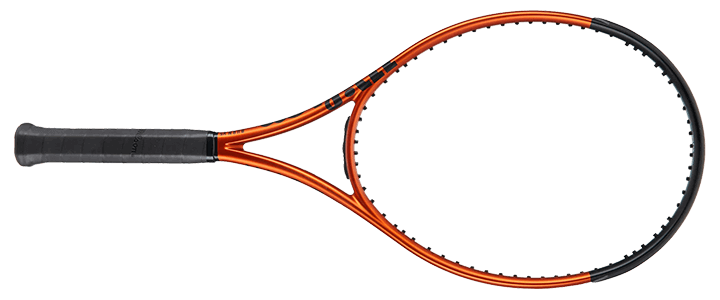
The Wilson Burn 100LS v5 is a low to medium-powered starter racquet that provides players with a solid mix of features at a surprisingly reasonable price point.
The Burn 100LS v5 also comes in at a strung weight of only 10.5 ounces, so it’s a quick racquet that’s easy to maneuver and ideal for beginners.
The head size is 100 square inches, the smallest I’d recommend for beginners to ensure plenty of margin for error when swinging to hit the ball. With an open string pattern of 18×16 and a stiffer frame with an RA rating of 72, this racquet delivers plenty of pop while making it extra easy to generate topspin.
Key Specs
| Head size | 100 in² / 645.16 cm² |
| Strung weight | 10.5oz / 298g |
| Power | Low |
| String Pattern | 18 Mains / 16 Crosses |
| Pre-strung | No |
Head Tennis Racquets
While new players might be familiar with Babolat and Wilson tennis racquets, Head is another hugely popular brand offering an impressive racquet lineup with fantastic beginner options.
Head Titanium Ti.S6
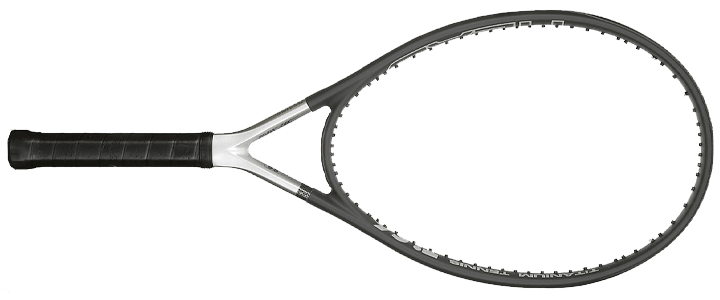
Head’s affordable Titanium series of tennis racquets has been a prevalent choice for beginners for years.
This model features the largest head size on the list at 115 square inches for a large sweet spot. This racquet provides tons of power, along with its titanium makeup and extended 27.75-inch length.
The Ti.S6 is also feather-light at 8.9 ounces and comes with a 16×19 string pattern, which, combined with a larger head size, makes this a spin-friendly tennis racquet.
Last but not least, this racquet also comes pre-strung and ready-to-go, which will save you some extra cash up-front.
Key Specs
| Head size | 115 in² / 742 cm² |
| Strung weight | 8.9oz / 252g |
| Power | High |
| String Pattern | 16 Mains / 19 Crosses |
| Pre-strung | Yes |
Head Speed PWR

At 9.7 oz strung, the Graphene 360+ Speed PWR is the lightest tennis racquet in Head’s Speed lineup.
However, it combines its lighter weight with an oversized 115 square inch head size and open 16×19 string pattern to deliver exceptional power with plenty of margin for error.
Overall, it’s another excellent option for beginners looking for an easy-to-use racquet that they can grow into as their skills improve.
Key Specs
| Head size | 115 in² / 742 cm² |
| Strung weight | 9.7oz / 275g |
| Power | High |
| String Pattern | 16 Mains / 19 Crosses |
| Pre-strung | No |
Head Instinct PWR

Key Specs
| Head size | 115 in² / 742 cm² |
| Strung weight | 8.6oz / 244g |
| Power | High |
| String Pattern | 16 Mains / 19 Crosses |
| Pre-strung | No |
Head Extreme PWR
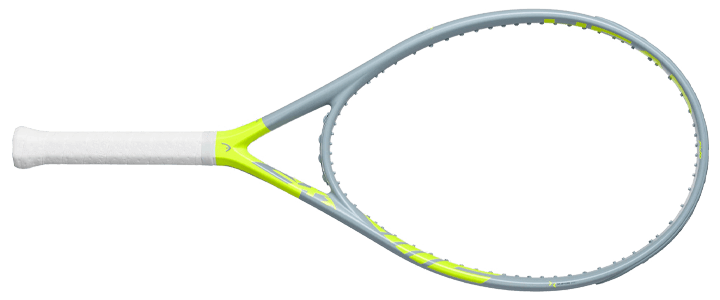
To round out Head’s options for beginners, you’ll also want to look at the Graphene 360+ Extreme PWR.
This option is more arm-friendly than the Speed and Instinct models, but it still delivers plenty of power and spin and has a generous head size.
Like the Instinct PWR, this racquet is easy to manage with a weight of 8.6 ounces, an extended 27.7-inch length, and a 16×19 string pattern.
Key Specs
| Head size | 1115 in² / 742 cm² |
| Strung weight | 8.6oz / 244g |
| Power | High |
| String Pattern | 16 Mains / 19 Crosses |
| Pre-strung | No |
Yonex Tennis Racquets
If you’re unfamiliar with Yonex, they’re an increasingly popular brand worth considering as you evaluate tennis racquets.
A defining feature of all Yonex tennis racquets is their Isometric Square Head Shape, which, according to them, increases the sweet spot of their racquets by 48%. It looks slightly different from the typical oval head shape, but don’t let that turn you off; they’re excellent racquets.
Yonex EZONE Ace
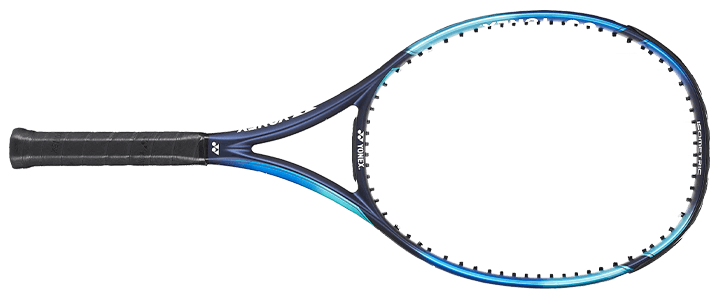
While many Yonex frames lean toward a more experienced audience, the Yonex EZONE Ace is an excellent option, hitting on many key attributes that new players will appreciate.
First, it comes with a 102 square inch head size, which is a great starting point, although smaller than others on the list. The racquet also weighs in at 9.7 ounces strung and features a 16×19 string pattern that will offer a nice blend of controlled power and topspin.
The EZONE Ace is also a reasonably comfortable tennis racquet that’s less stiff than others on the list, making it a worthy contender for players concerned about the health of their dominant arm.
Key Specs
| Head size | 102 in² / 658 in² |
| Strung weight | 9.7oz / 275g |
| Power | Medium |
| String Pattern | 16 Mains / 18 Crosses |
| Pre-strung | No |
Prince Tennis Racquets
Prince is a well-established brand in the tennis world that has helped define and shape modern racquet and string technology. Today, they continue to offer a fantastic line of tennis racquets worth checking out for any players new to the sport.
Prince Textreme Warrior 100L

With many tennis racquets in their lineup, the Prince Textreme Warrior 100L stands out as their most beginner-friendly.
While the head size is the smallest size I’d recommend for beginners at 100 square inches, it fits right into the pack of other racquets on this list, weighing in at an easy-to-maneuver 9.6 ounces. However, a good chunk of that weight makes its way into the head of the racquet, so it still feels solid and stable when hitting.
Like the Yonex EZONE Ace, it also leans toward more control with a lower stiffness rating emphasizing feel while offering restrained power in a spin-friendly package.
Key Specs
| Head size | 100 in² / 645 in² |
| Strung weight | 9.0oz / 255g |
| Power | Low |
| String Pattern | 16 Mains / 18 Crosses |
| Pre-strung | No |
Tecnifibre Tennis Racquets
Tecnifibre was well-known for its strings for years, but they’ve continued to grow and develop its racquet line successfully. More recently, endorsements from players like Daniil Medvedev, Iga Swaitek, Jeremy Chardy, and John Millman have helped increase their exposure.
Tecnifibre TF-X1 275
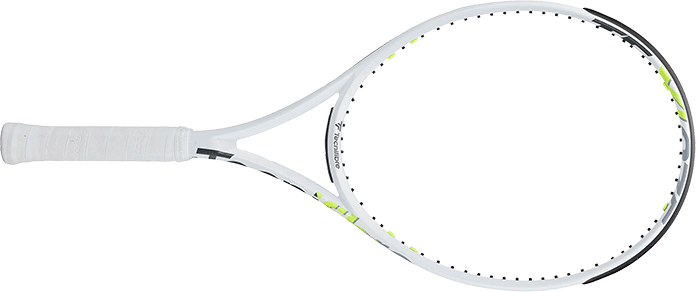
At 10.2 ounces, the TF-X1 275 is a lightweight tennis racquet that swings easily to generate power and topspin.
The racquet has a 105 square inch head size, plenty sufficient for beginners, and a 16×19 string pattern.
Although you may not be familiar with the brand, Tecnfibire is a well-respected option for beginners.
Key Specs
| Head size | 100 in² / 645 in² |
| Strung weight | 10.2oz / 289g |
| Power | Low |
| String Pattern | 16 Mains / 19 Crosses |
| Pre-strung | No |
How to Choose the Right Racquet
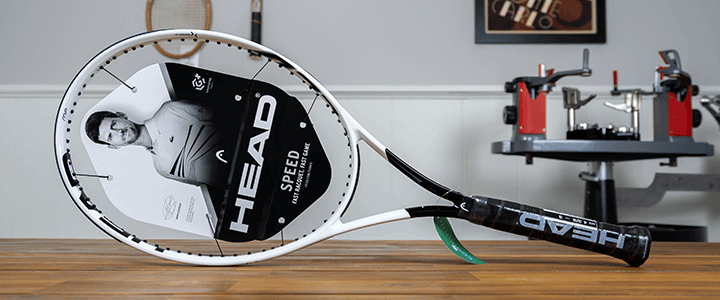
If you’ve made it this far, you may still feel overwhelmed by where to start and which racquets on this list are the best for you.
To help, it’s worth considering your personal preferences. Here’s a brief list to consider that will narrow the above list quite a bit:
- Affinity toward a specific brand
- A desire for a lightweight racquet
- The need for a high-comfort frame
- A large head size to increase your margin for error
Do any of these resonate with you? If so, then you’ve just narrowed your options. For example, if you’re really into Babolat racquets, you have three great options on my list.
Of course, remember to revisit the two questions at the beginning of this guide. If your racquet’s price is a concern or you’re unsure whether you’ll like playing tennis, those considerations will also limit your selection to the more affordable options on the list.
If you’re still stuck, the best way to choose a tennis racquet is to get out on a tennis court and demo some racquets.
Your local tennis club or pro shop will likely have a few on hand you can try, and even if they’re not on the list, you can take note of their attributes like weight and head size to use as a point of reference when considering the racquets on the list.
Another route you can take is ordering any of these racquets through one of the demo programs available through online retailers.
Common Questions

New players often have many questions when looking for a new tennis racquet. Here are some of the top questions I hear often.
How much does a good beginner’s racquet cost?
Many excellent beginner’s tennis racquets cost less than $150. However, dedicated beginners might consider spending more to find a high-quality tennis racquet they can grow into as their skills develop.
I recommend spending what you feel good about and can reasonably afford – there’s no right or wrong answer here.
What should I look for in a beginner tennis racquet?
As a beginner, here’s a quick checklist you can use to help point you in the right direction for your first tennis racquet:
- Head size: at least 100 square inches
- Weight: no heavier than 10.5 ounces
- Grip size: the right size that feels good in your hand
If you can check all those boxes, you’ve likely found a tennis racquet that will work well for learning to play tennis.
What tennis racquet brand is the best?
The three most popular tennis brands are Wilson, Babolat, and Head. However, it’s better to consider each brand as different instead of better than the other. Any advice counter to that is subjective.
Remember that Roger Federer uses Wilson, Rafael Nadal uses Babolat, and Novak Djokovic uses Head, and they’ve all done pretty well.
Is a lighter or heavier tennis racquet better for beginners?
Lighter racquets with larger head sizes that are easy to maneuver are suitable for beginners.
As your technique improves, you’ll likely transition to a heavier racquet with a smaller head size. Said another way, there is a time and a place for light and heavy tennis racquets.
All things being equal, a lighter racquet will be easier to maneuver, while a heavier racquet will offer more power. For more information, check out my article on racquet weight and balance.
Wrapping Up
Finding your first tennis racquet as a beginner can be overwhelming. You don’t want to overspend or make a poor choice that you’ll regret, but you also don’t want to overanalyze and waste time making a decision.
Hopefully, if you spend quality time researching, including what you learned in this guide, you’ll feel more confident that your purchase is a good fit for learning how to play.
If you have questions or need help picking out a tennis racquet, drop me a note in the comments below. I’d love to answer any questions you have.
Play Better Tennis
Improve your game alongside our community of tennis players
Why join?
Discussion Boards
Join the conversation with other members of the community.
5 Point Friday
Read our weekly recap of the 5 most interesting things we dig up in tennis.
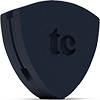
![15 Best Tennis Racquets for Beginners in 2024 [Buyer's Guide] A Selection of Four of The Best Tennis Racquets for Beginners fro Wilson, Babolat, Yonex, and Head](https://tenniscompanion.org/wp-content/uploads/2024/01/15-best-tennis-racquets-for-beginners-2024-buyers-guide.png)

Leave a Reply
Want to join the discussion?Feel free to contribute!